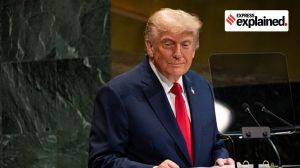When Clinton talks about his tandoori nights
WASHINGTON, SEPT 25: In the high-stakes diplomatic game that is being played out in Washington, New Delhi may have discovered an appetisin...

WASHINGTON, SEPT 25: In the high-stakes diplomatic game that is being played out in Washington, New Delhi may have discovered an appetising trump card: Indian cuisine.
For long a malnourished cousin of the more celebrated French, Italian, Greek and even Thai and Vietnamese cuisine, Indian food is beginning to get therecognition it craved for. Among its biggest promoters — the White House, President Clinton, and senior officials of the Democratic dispensation.
Just how intense the Indian food fad has become was evident at last week’s White House dinner. The elite guest list included Raji Jallepalli, chef and owner of the Indian fusion food place Restaurant Raji in Memphis, and Sant Singh Chhatwal and his family, owners of a chain of Indian restaurants across the United States.
Both got an entree on the strength of the Clintons’ Indian food fetish. In fact, only the week before, the President and the First Lady visited the Chhatwals’ home in New York, where more than food was on the menu.
President Clinton’s gluttony is well chronicled here and his appetite for burgers and fries is a staple for late night comics. What is less well known is his taste for Indian food that extends well beyond periodic forays to the Bombay Club, an upscale Indian restaurant located right across the White House.
At an Indian-American fund-raiser in Silicon Valley over the weekend, Clinton let on to the secret of his taste for tandoori. As a broke student during his Oxford years (he was a Rhodes scholar there), he survived on Indian food in London, where curry and naan is as English as burger and fries is American.
One recent estimate put the number of Indian restaurants in England at 80,000. It is said they employ more people than the British steel and shipping industry put together.
America appears to be following suit, although its vastness and its more recent ties to India makes the proliferation of Indian restaurants much less visible.
While Indian eating places are opening by the scores in New York, Washington, San Francisco, Chicago and other centers of Indian concentration, restaurants are also springing up in places as distant as Memphis and Denver. Indian cookbooks, a newer presence in thecuisine section of book stores, are flying off the shelves.
Food seems an appropriate metaphor to describe the two honeymooning countries. American society is usually referred to as a melting pot, while India’s more distinct pluralism lends itself to being called asalad bar.
Incidentally, the Clintons are not the only ones who have developed a taste for Indian food. Several past, present and potential members of the Democratic administration are loyal to Indian cuisine. While regular at Downtown Washington’s Bombay Palace, Al Gore’s National Security Adviser Leon Fuerth prefers Bombay Bistro in the suburb of Vienna.
But clearly President Clinton takes the lead — both in terms of bite and byte. At the Silicon Valley fund-raising dinner, Clinton was quoted as saying he and his friends in England ate Indian food at least four times a week because “if we couldn’t be full, at least we would be warm and we loved it.”
That Indian warmth may now extend from food to festivals. Reports said that Clinton was open to a suggestion from his hosts that the White Housecelebrate Diwali this year, since he had a taste of Holi during his visit to New Delhi in March.
Clinton’s passion for desi food however did not translate itself into an Indian menu at the White House dinner last week, where the rajbhog was entirely western.
However, the White House did send its dessert specialist Dr Ronald Meissner to consult with Indian officials to look for appropriate motifs.
Dr Meissner produced a dessert in the shape of a saffron lotus made from mango, banana and ichees in raspberry sauce, much to the delight of the BJPloyalists. For the more nationalistic-minded there was a second dessert called `a majestic tiger’s delight’ that had a white tiger set in green foliage surrounded by exotic chocolates.
Photos



- 01
- 02
- 03
- 04
- 05




























